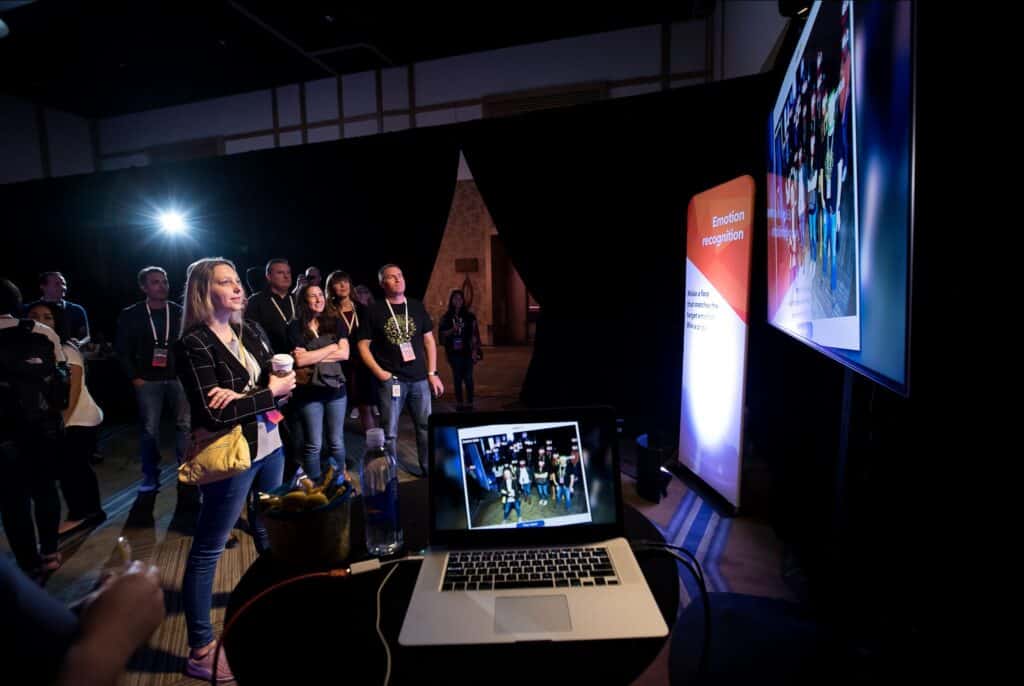From unlocking your iPhone to breezing through customs at the airport, facial recognition technology is popping up in a variety of industries. It’s transforming how people verify their identity.
Within the events industry, facial recognition enhances efficiency and streamlines security. It also offers event organizers insightful feedback on their attendees’ experience. To learn how it provides all these benefits, let’s dive into what facial recognition is and how this event technology works.
What is Facial Recognition Technology?
So what is facial recognition technology? It’s biometric software that analyzes data from a person’s photo, like their facial features and contour patterns. It translates this data into an algorithm, commonly referred to as a “facial fingerprint.” This data is then used to identify individuals during security checks.
In other words, facial recognition technology allows people to conveniently use their face as their identification, rather than an ID or emailed invitation confirmation. This benefits both event organizers and attendees alike by saving their time, boosting security, and providing a hassle-free registration and check-in process.
The Facial Recognition Industry
The facial recognition industry has been experiencing dramatic growth recently, and it’s only expected to increase over time. Here are some notable facts about the current market landscape:
- The facial recognition market was worth 07 billion in 2019
- This industry is anticipated to be worth 19 billion by 2025.
- Government initiatives and surveillance companies are the leading adopters of this biometric technology.
- The United States and China are leading countries making use of this technology.
As you can see, facial recognition technology is likely to expand its reach into a plethora of industries in the next few years. The events industry is already adopting it in droves. Let’s take a look at how it’s being used at corporate events, trade shows, and conferences.
Employing Facial Recognition at Events
To try out facial recognition technology at your next event, start the process early on. Ask attendees to submit a photo of their face when they RSVP to your invitation. Allow invitees to opt-in, rather than requiring them to, since people are still warming up to this technology.
Some may not be comfortable with it yet, and that’s okay.
Next, your facial recognition software will analyze the submitted photos and transform them into data. Once everyone’s “facial fingerprint” is encoded into the database, it can be used to verify identities at your event’s security checkpoint.
Address Your Attendees’ Concerns About Facial Recognition Events
While face recognition has many positive uses, people often fear new technologies. It’s a tale as old as time. To some, having your face scanned and analyzed can feel invasive. To ensure that each attendee feels more comfortable opting-in, give them some insight into the privacy protections of your facial recognition software.
Here are some questions that your event guests may have in regards to face recognition technology:
- Who has access to my submitted photo and facial fingerprint data?
- How well is this information secured?
- How long will my data be stored?
- How will my facial fingerprint be used after the event?
To address these concerns, make sure people know that a database doesn’t store submitted photos. It only stores the associated “facial fingerprint” algorithm. Furthermore, the creators of facial recognition software take privacy extremely seriously. They build in a plethora of security safeguards every step of the way. Transparency about these topics will help put your guests at ease.
How Do People Feel About Facial Recognition Events?
While concerns are natural, people are likely to warm up to face recognition as time goes on. For example, the real estate company, Keller Williams, gave facial recognition technology a try at some of their conferences.
Here’s what they found:
- The first time around, only 45% of their audience opted in to use facial recognition.
- By their fifth event, 68% opted-in to use facial recognition technology. That’s over a 50% increase in opt-ins!
As you can see, more people will opt-in as they get used to the technology. Event attendees will see the benefits of it in action as they enjoy speedy check-ins. This will help them feel more open to using it the next time around.
The Benefits of Using Facial Recognition For Events
For event throwers and attendees alike, facial recognition has the power to streamline events by enhancing convenience and security. It offers even more benefits for event throwers who want to analyze the success of their event in post.
Let’s take a look at how facial recognition offers these benefits.
Enhancing the Efficiency of Check-Ins
We’ve all attended events where we rush to get there on time, only to find a long line between us and the entrance. This is a frustrating experience. It starts the event off poorly. Fortunately, facial recognition technology can ease this problem. Facial recognition reduces long lines by checking in guests with a fast and simple facial scan.
No longer will attendees be forced to ruffle through their purses and pockets to find proper identification. They also won’t need to waste time scrolling through their email to find their invite confirmation. They can simply verify their admittance by looking into a camera. If their identity checks out, they’re good to go. This process only takes a few seconds.
Improving check-in is one of the most useful applications of facial recognition technology for meetings and events. Even if only 70% of your attendees opt-in and submit their photos, you can expect to see at least a 10% improvement in overall check-in efficiency.
Improving Event Security
Crashing an event is all too easy without facial recognition technology. Uninvited guests can sneak in using the following tactics:
- Forging a fake ID.
- Borrowing someone else’s ID.
- Asking a guest to forward their email confirmation.
- Acquiring a ticket or invitation that belongs to someone else.
On the other hand, your face is not something you can fake or forge without drastic measures. By using biometric data as the standard for entrance, security is enhanced in an unparalleled way. That’s why even law enforcement like the United States Customs and Border Protection is rolling it out in many airports.
While facial recognition may seem excessive for some events, it ensures that everyone in the event is who they say they are. Not only does this improve safety, but it gives invited guests greater peace of mind. Facial recognition may also keep virtual and hybrid events more secure by keeping out people who should not be in the meeting.
Reducing Security Burdens on Event Staff
Furthermore, facial recognition makes it easier than ever for event staff to separate VIPs from general attendees.
They won’t have to worry about someone borrowing a VIP wristband from a fellow colleague. They can also use facial recognition to allow presenters and speakers into restricted areas with ease.
If a person were to enter and be flagged as an unauthorized guest, security staff can step in to look into the situation. Facial recognition isn’t perfect yet, so there’s always a possibility that it makes a mistake. However, it’s much better to deal with uninvited guests at the entrance than within the event itself.
Helps Optimize Future Events with Data Analysis
In addition to elevating the efficiency and safety of your event, facial recognition technology can collect important data that will help optimize your future events. Here are a few ways it does this:
- Session tracking: Facial recognition lets you track who attends specific sessions of your event. By analyzing this data, you gain valuable insights into their experience. If you notice a sharp decline in attendance before a specific speaker, you can conclude that the interest level was low for their talk. Speakers are expensive, so you want to make sure your attendees found the presentations worthwhile.
- Emotional scoring: You can measure event satisfaction by using emotional recognition. This is a facet of facial recognition technology. It lets you amass data on your attendees’ emotional reactions to different events. For example, you can track the reaction of a crowd to various points within a speaker’s presentation and measure how engaged they were.
- Eliminate the need for post-event feedback: Feedback is a critical resource for optimization, but asking for it from event attendees has mixed results. The request can easily go ignored, or at best, feel tedious to the person filling it out. Event attendees may also respond dishonestly. Avoid this annoying process altogether by analyzing attendees’ experience yourself through emotional scoring technology.
As you review the data from your most recent event, you can optimize future events accordingly. This will ensure that you choose the best speakers, design the optimal venue, and provide a highly engaging experience.
Facial Recognition Events: Skyrocket Your Next Event’s Success
As you can see, facial recognition technology is a powerful tool that’s rapidly expanding throughout various industries. It can transform events by improving efficiency, boosting security, and providing data for future event optimization.
For more cutting-edge event tech solutions, check out Vario’s new event portfolio highlight: Allergan’s Annual MIND Summit. This event utilized a plethora of powerful new event tech trends. For example, they showcased mixed reality in the form of a hologram presentation. As a result, they saw incredible engagement. See how their event delighted attendees in our full portfolio showcase. To learn more about event technology like live streaming events, visit Vario today.







